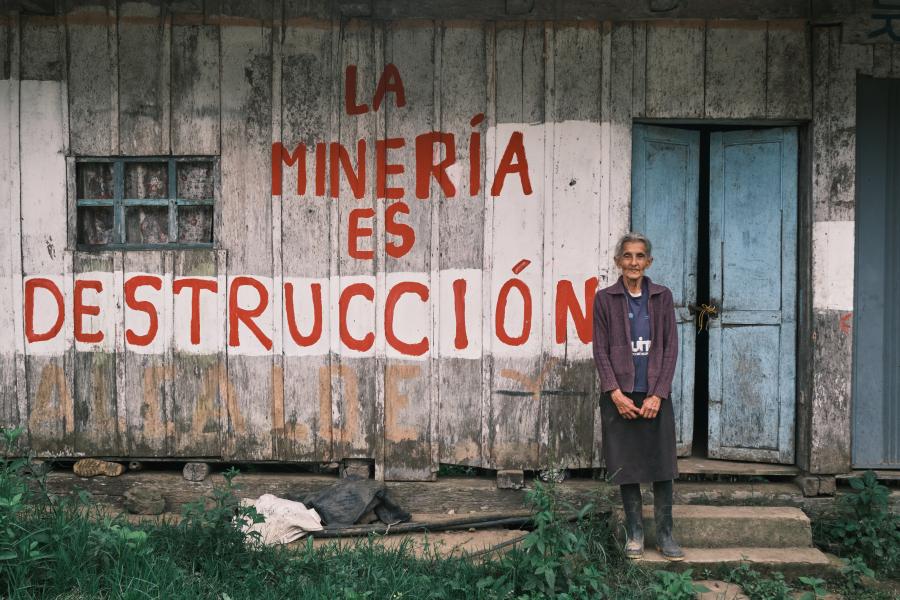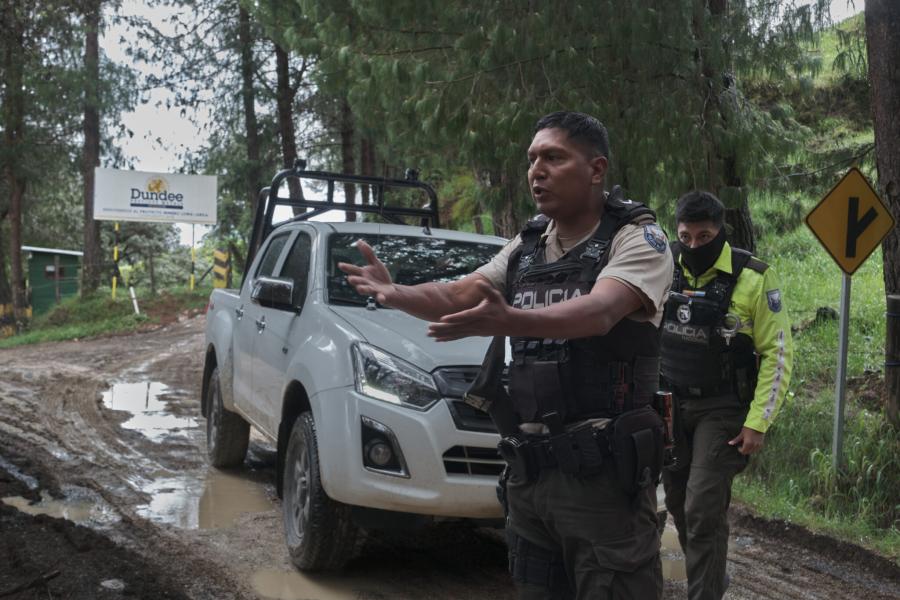Quichua Indians Threatened by Development
In Coca, a pioneer city at the junction of Ecuador's Coca and Napo rivers, tension fills the air. Armed troops patrol the streets. Since the African Palm firms of Palmoriente S.A. and Palmeras de Ecuador S.A. Revealed that they each wanted to expand their African Palm plantations of 10,000 hectares to 200,000 hectares, a land speculation boom has begun.
To expand the plantations will require a renewed clearing of the Amazonian rain forests. In Ecuador, only 100,000 km +/- (10,000,000 hectares) of rain forest exists. Clearing the forest will bring about an irretrievable loss of species and will alter the climate. By early 1985 many already complained about the long dry spells which they blamed on previous clear cutting of rain forests. Further, clearing of the forest will also force the expulsion of the Quichua Indians, who pursue a traditional subsistence way of life in the forest in comunas (communities), as well as the colonists who established themselves along roads built during the last few years of petroleum exploitation. Many of these Indians and mestizos from the highlands of Ecuador left overcrowded lands for the paradise the government promised in the primeval forest.
Foreign Countries Support Palm Oil Development
Both Ecuadorian palm oil corporations operate with 40 percent foreign participation. One of the largest financers, the German Development Company (DEC) has already contributed DM 13.1 million to the Palmoriente S.A. in Huashito, of which DM 3.1 million are shares and DM 10 million are loans. The DEC defended their investment in their 1984 annual report.
Ecuador has hastened the development of those branches of the economy which affect the living standards of the majority of the population as directly as possible and promote social progress. This project has a part in the economic integration of the Ecuadorian Amazon basin. It will create about 770 jobs and introduce a modern plantation technology to an underdeveloped region. Production is intended exclusively for the internal market, so that dependence on imports will be lessened.
The annual report, however, failed to include that:
* The project contributes to the destruction of Ecuador's highly sensitive Amazon rain forest as well as the fertility of the soil.
* The first 10,000 ha, developed by Palmeras de Ecuador S.A. with the DM 13.1 million-DEG financing, was part of a pilot project for another 100,000 ha.
* Another pilot project conducted by the firm Palmeras de Ecuador S.A. in Shushufindi, only 40 km away, is also to be expanded to 100,000 ha.
* 10-15 percent of the Ecuadorian Amazonian rain forest has already been destroyed by colonization, road construction and petroleum exploitation.
* The myths of the fertility of this Amazon region propagated by the government are supported by DEG'S financing of economic activities in the rain forest. Instead of financing this project, DEC should push for a radical land reform in the coastal and highland areas.
The DEG'S statement that palm oil is produced exclusively for Ecuador's internal market is contradicted by a National Bank document in Ecuador (Informe 84-012-SE1 of December 3, 1984). This document anticipates exporting 200,000 mt of oil in the near future, to be increased later by another 400,000 mt when all 200,000 ha of the oil palms are producing. Clearly exports will have to be encouraged in order to pay back DEG'S loans.
Plantation Workers Isolated
The "social progress" supported by the DEC and the "jobs" created at the oil palm plantation are also suspect.
* Employees are recruited and paid by contratistas (contractors).
* Employees are hired without contracts according to a system of rotating employees. Thus workers are denied social and health insurance benefits as well as additional monthly salaries, overtime and vacation pay. Short-changing employees is estimated to save the firm up to 45 percent per employee.
* Labor unions are prohibited.
At the end of 1983 there was a major labor conflict at the Palmoriente S.A. plantation. As a result a week-long strike erupted and workers took over part of the plantation. Management employed special units of the national police and the strike ended. One hundred seventy workers were fired.
Since that time, the plantation has been shielded from the outside and guarded by a security system. Information regarding incidents such as work accidents (caused, for example, by using the toxic spraying compounds Aldrin and Endrin) rarely reaches the outside. If it does, it is only as rumors, which are difficult to investigate. Last February, for instance, it was revealed that one worker had supposedly died of pesticide poisoning and another had become very ill. In 1982 members of the community "Corazon del Oriente" observed that large numbers of fish died in the Huashito, a small river which flows through their communal land and whose origin is predominantly inside the oil palm plantation. Since the families drew their drinking water principally from the Huashito, they went to the source of the fish dying and found out that spraying compounds used against insects (probably Aldrin) had gotten into the river on the oil palm plantations.
Developers Speculate on Indian Land
Since 1979 Palmaoriente S.A.'s work in the Huashito region has been financed with German capital, and the corporation has increasingly pressured previous colonists to sell their land or leave. It was, for example, "suggested" to the Comuna Huaysa several times to transfer to the company 1,000 ha of reservation lands which border the Palmoriente Plantation. In return they were promised a free road, school and health center. It was also indicated that there would be lucrative job possibilities on the plantation. The director of the Ecuadorian Institute of Agrarian Reform and Colonization (IERAC) in Coca also demanded that the comuna hand over 1,000 ha to the enterprise. The comuna rejected all demands and offers.
Now many colonists who settled in Coca realize that they are victims of government propaganda about the supposedly enormous fertility of the rain forest soil. Each year the land has brought fewer crops. Over the last few years many have been willing to sell their land to the speculators.
The Indian communities are also under increasing pressure from the land speculators to sell their lands. The palm oil firms are calling in shrewd lawyers from the coast to handle land sale agreements. The mayor's office in Coca is now also about to establish a firm in order not to lose out on the chance to capitalize on the land boom.
It goes without saying that the Quichua have great hesitations and fear that such a large project will destroy their forest - the basis of their existence - or that they will be unable to defend their land rights.
It is difficult for the Quichua to understand why all of a sudden, after centuries of disinterest, discrimination, land grabbing and neglect, everyone is taking an interest in them. It does not make much sense to them to cut their forest, which they live in and use in a traditional way, in order to plant four or five fast growing "commercial" kinds of trees which they will be allowed to harvest only after 15 years. They have already had negative experiences with imported, Western systems of utilizing the rain forests. In the recent past for example, lumber companies took precious timber from communities close to the road and paid only 200 sucres (about $1.50) per log. In the process, they caused a great deal of forest damage.
Reforestation Program May Invalidate Indians' Land Titles
The US Agency for International Development (USAID) is eager to include the existing forest of the Quichua comunas in its reforestation program. Yet, those settled in small dwellings along the roads need reforestation much more, since they have totally cleared the forest for agricultural production. Why aren't the independent Indian organizations allowed to execute the development plan they devised themselves? The regional organization FCUNAE (Federation of Communities - Union of Ecuadorian Amazonian Natives), for example, employs an engineer to survey the land with the community in order to title all comuna land.
In February 1985, an unconfirmed report surfaced that the government wanted to declare the Indians' and colonists' land a National Forest. Such a declaration would invalidate all former land titles of the Quichua comunas and the small settlers and enable the government to open up the land to lumber companies.
The USAID reforestation project is now being used by the Ecuadorian government to legitimize its own programs in the area. The USAID project allows the government to direct public attention to the reforestation program so that large areas of forest can be cleared, largely unnoticed, for the lumber and oil palm corporations.
CONFENIAE (Confederation of Indian Nations of Ecuadorian Amazon), whose headquarters are in Quito, supports the struggle of FCUNAE, which is an affiliate of their organization. They have documented the effects of African Palms as a monoculture in the Amazon rain forest as well as the dangers of pesticide use to the environment. CONFENIAE's publication, 0)7 Palm Plantations in Amazon Lowland of Ecuador - a Large Scale Agroindustrial Project Threatens the Indians' Territory, is a call for help to ecologists and solidarity groups around the world, especially those in France, Belgium, Luxembourg, England and West Germany, the countries that provide financial support and "know-how" for the palm oil plantations. The document can be obtained in Spanish from CONFENIAE, Apto 4180, Quito, Ecuador for $5.00 and in German from FIAN, Postfach 1302, 6906 Leimen, West Germany.
Article copyright Cultural Survival, Inc.



